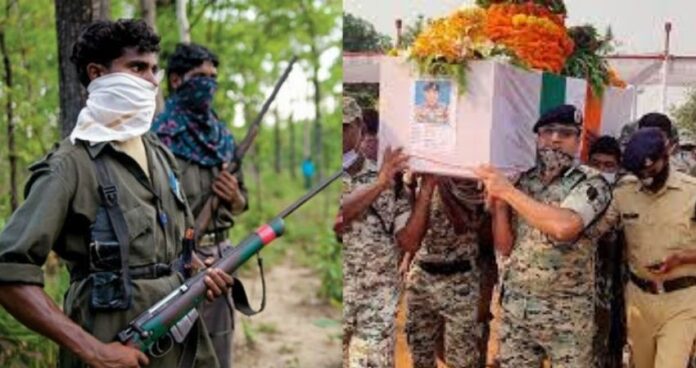Indian government has been tangled up in a historical conflict against armed Maoist rebels, locally known as Naxals. They periodically launch attacks on the Indian forces to express their rebellion against the government system of India. They are mostly active in tribal areas of Chhattisgarh and Jharkhand. The Indian government has imposed heavy security crackdowns on Maoists but the violence has only increased. Hundreds of people including soldiers, rebels, and Adivasis (indigenous people) are being killed each year in clashes between Maoists and Indian forces.
Their most recent battle took place on Sunday 4th April in the areas surrounding the Sukma-Bijapur border, which was one of the key strongholds of Naxal militants. According to reports, the rebels laid an ambush for the security forces that killed 22 personnel and wounded at least 30.
The rebels captured one officer but freed him on 8th April after alleged talks with the Indian government.
Reportedly, two social activists collected the released commando and brought him back him on a motorbike.
Who Are Maoist Rebels?
The Maoist insurgency dates back to 1967 when a farmer was unable to cultivate crops on his own land due to government restrictions. It led to the first armed uprising from the remote Naxalbari village in West Bengal, hence the name, Naxals. The rebels developed a strong hatred for the government’s capitalistic approach to the economy even after gaining independence from the British. They were alas silenced after a couple of months but more revolutionaries were inspired to continue the anti-colonial struggle.
Maoist rebels are inspired by the doctrine developed by Chinese revolutionary leader Mao Zedong. They aim to overthrow the government’s power only through the Protracted People’s War, which Mao advocated as a military strategy. Rebels claim that they are fighting for legitimate socio-economic rights of Adivasis that have been left behind in India’s economic growth. They say that they will bring communism to India and eliminate capitalism, Imperialism, and feudalism.
Their political party’s name is Communist Party of India (Maoist) and the People’s Liberation Guerrilla Army (PLGA) serves as its armed division. Pro-Communists have agreed with the ideology of Naxals but pro-government nationalists suggest that Indian forces must conduct strong operations against the rebels, just like it is doing in Kashmir.
The Red Corridor
The Indian government has deployed thousands of troops in Maoist areas (known as Red Corridor) in the last 10 years and has considerably minimized the presence of militants. In the beginning of insurgency, Maoist rebels had 200 districts across 20 states and now they have 106 in 10 states. Ever since the government started counterinsurgency, the reports of casualties, especially civilians started to grow. The central and eastern region where Maoist rebels are dominant is home to 84 million Adivasis.
The majority were already living in extreme subsistence and the government restored mining activity in the region, which presented greater threats to their livelihoods. Even though the region is mineral-rich, it is still lacking in drinking water, education, healthcare, and roads. Therefore, it was agonizing for the locals to witness the push towards industrialized mining when locals were deprived of basic facilities. In anguish, rebels have been ambushing Indian forces, destroying government offices, and capturing officials to make a point. As per popular opinion, it is useless to fight against the rebels who just want the government to promote equal rights for the community. It is also known that Maoist militants fight much harder than the soldiers trained by a government or military institution.
An unsolicited video appeared on social media which led some to wonder if battle strategy of Maoist rebels is far superior to Indian forces. Retired Lieutenant General H. S. Panag, Father of Indian actress Gul Panag, also argued if India is using the right way to deal with rebels.
How Can the Violence End?
The violence does not seem to end anytime soon as the Indian nation is highly polarized on this issue as well. Half of it considers Maoist insurgency as an internal security threat for India, while others consider them a terrorist organization. Indian Government has also refused to acknowledge Maoist rebels as an internal security threat and decided to use invasive force. Critics and opposition of BJP led government have also deemed it a weak response that will solve no issue.
Rebels helped the tribal people by redistributing land and guarding the forest so, many locals have either supported or joined them. They have accused security forces of various crimes including mass sexual abuse, human rights violation, and extrajudicial killings. Human rights activists and reporters have faced targeted harassment for highlighting unlawful acts of Indian forces.
Villagers who are recruited by rebels, face additional oppression from sides. Government forces arrest and torture them for information and rebels kill and brutalize them after accusing them of being police informants. Tens of thousands of Adivasis have been sacrificed in the battle of supremacy between Indian forces and Maoist rebels.
Also Read
What Is BDS Movement and Why It’s Being Declared Anti-Semitic?


